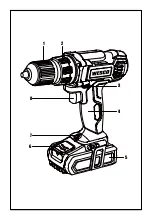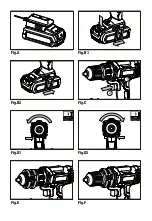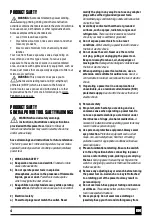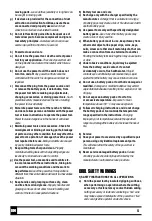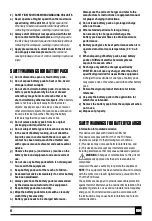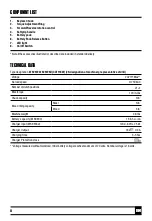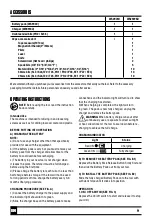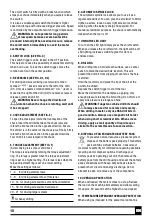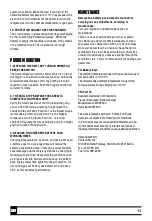
6
EN
2) SAFETY INSTRUCTIONS WHEN USING LONG DRILL BITS
a) Never operate at higher speed than the maximum
speed rating of the drill bit.
At higher speeds, the
bit is likely to bend if allowed to rotate freely without
contacting the workpiece, resulting in personal injury.
b) Always start drilling at low speed and with the bit
tip in contact with the workpiece.
At higher speeds,
the bit is likely to bend if allowed to rotate freely without
contacting the workpiece, resulting in personal injury.
c) Apply pressure only in direct line with the bit and
do not apply excessive pressure.
Bits can bend
causing breakage or loss of control, resulting in personal
injury.
SAFETY WARNINGS FOR BATTERY PACK
a) Do not dismantle, open or shred battery pack.
b) Do not expose battery pack to heat or fire. Avoid
storage in direct sunlight.
c) Do not short-circuit a battery pack. Do not store
battery packs haphazardly in a box or drawer
where they may short-circuit each other or be
short-circuited by other metal objects.
When battery
pack is not in use, keep it away from other metal
objects, like paper clips, coins, keys, nails, screws or
other small metal objects, that can make a connection
from one terminal to another. Shorting the battery
terminals together may cause burns or fire.
d) Do not remove battery pack from its original
packaging until required for use.
e) Do not subject battery pack to mechanical shock.
f) In the event of battery leaking, do not allow the
liquid to come in contact with the skin or eyes. If
contact has been made, wash the affected area
with copious amounts of water and seek medical
advice.
g) Observe the plus (+) and minus (–) marks on the
battery back and equipment and ensure correct
use.
h) Do not use any battery pack which is not designed
for use with the equipment.
i) Keep battery pack out of the reach of children.
j) Seek medical advice immediately if a cell or battery
has been swallowed.
k) Always purchase the battery pack recommended
by the device manufacturer for the equipment.
l) Keep battery pack clean and dry.
m) Wipe the battery pack terminals with a clean dry
cloth if they become dirty.
n) Battery pack needs to be charged before use.
Always use the correct charger and refer to the
manufacturer’s instructions or equipment manual
for proper charging instructions.
o) Do not leave battery pack on prolonged charge
when not in use.
p) After extended periods of storage, it may
be necessary to charge and discharge the
battery pack several times to obtain maximum
performance.
q) Battery pack gives its best performance when it is
operated at normal room temperature (20 °C ± 5
°C).
r) When disposing of battery packs, keep battery
packs of different electrochemical systems
separate from each other.
s) Recharge only with the charger specified by
POSITEC. Do not use any charger other than that
specifically provided for use with the equipment.
A charger that is suitable for one type of battery pack
may create a risk of fire when used with another battery
pack.
t) Retain the original product literature for future
reference.
u) Use only the battery pack in the application for
which it was intended.
v) Remove the battery pack from the equipment when
not in use.
w) Dispose of properly.
SAFETY WARNINGS FOR BATTERY CHARGER
Information for radiated emission
This device complies with Canadian ICES-001.
This device complies with Part 15 of the FCC Rules.
Operation is subject to the following two conditions:
(1) This device may not cause harmful interference, and
(2) This device must accept any interference received,
including interference that may cause undesired operation.
WARNING:
Changes or modifications to this unit not
expressly approved by the party responsible for
compliance
could void the user’s authority to operate the equipment.
NOTE:
This equipment has been tested and found to comply
with the limits for a Class B digital device, pursuant to Part
15 of the FCC Rules.
These limits are designed to provide reasonable protection
against harmful interference in a residential installation. This
equipment generates, uses and can radiate radio frequency
energy and, if not installed and used in accordance with
the instructions, may cause harmful interference to radio
communications.


